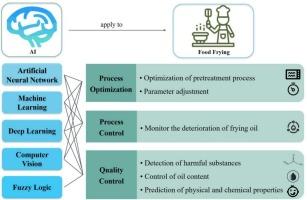人工智能增强的可持续食品油炸:综合综述
IF 8
1区 农林科学
Q1 FOOD SCIENCE & TECHNOLOGY
引用次数: 0
摘要
油炸是一种重要的食品加工方法,油炸食品因其独特的色泽、风味和质地,在日常饮食中也占有重要的地位。然而,由于食品油炸是在持续高温条件下进行的,不可避免地会产生某些有害物质。此外,反复使用煎炸油进一步加剧了这种情况。同时,油炸食品的高含油量也是消费者关注的问题。人工智能(AI)与传统分析技术的结合为有效控制上述问题提供了创新的解决方案。本文综述了近十年来各研究者的主要研究成果。重点介绍了人工智能在油炸食品工艺优化、过程控制和质量保证中的应用。特别是机器学习、人工神经网络和计算机视觉系统在监测煎炸油变质和预测有害物质形成方面发挥着重要作用。在食品油炸领域,人工智能的引入带来了优势,也带来了挑战。人工智能具有强大的自学习能力,具有高效、准确、多目标优化、可持续性强等优势。与此同时,人工智能正处于快速发展阶段。在食品油炸的应用中,也面临着数据困境、投资压力大、监管困境等挑战,仍有相当大的提升空间。展望未来,随着人工智能技术的不断进步,以及物联网、区块链等配套技术的融合,油炸食品的个性化定制、智能化生产、全链监管和可追溯性都可以实现。在人工智能技术的支持下,油炸行业将朝着智能化、可持续性的方向发展。本文章由计算机程序翻译,如有差异,请以英文原文为准。

Sustainable food frying enhanced by AI: A comprehensive review
Frying is an important food processing method, and fried foods also play an important role in daily diets because of their unique color, flavor and texture. However, as food frying occurs under continuous high-temperature conditions, it is inevitable that certain harmful substances will be generated. Moreover, the repeated use of frying oil further aggravates this situation. Meanwhile, the high oil content of fried foods is also a concern for consumers. The combination of artificial intelligence (AI) and traditional analytical techniques offers innovative solutions for effectively controlling the problems mentioned above. This article reviews key research achievements by various researchers over the past decade. The application of AI in the process optimization, process control, and quality assurance of fried foods is highlighted. In particular, machine learning, artificial neural networks, and computer vision system play significant roles in monitoring the deterioration of frying oil and predicting the formation of harmful substances. In the field of food frying, the introduction of AI brings both advantages and challenges. AI, with its powerful self-learning ability, demonstrates advantages such as high efficiency, accuracy, multi-objective optimization, and strong sustainability. Meanwhile, AI is in a stage of rapid development. In the application of food frying, it also faces challenges such as data dilemma, high investment pressure, and regulatory predicament, and there remains considerable potential for enhancement. Looking ahead, with the continuous advancement of AI technologies and the integration of supporting technologies such as the Internet of Things and blockchain, personalized customization, intelligent production, full-chain supervision and traceability of fried foods can be achieved. With the support of AI technologies, the food frying industry will develop towards intelligence and sustainability.
求助全文
通过发布文献求助,成功后即可免费获取论文全文。
去求助
来源期刊

Food Research International
工程技术-食品科技
CiteScore
12.50
自引率
7.40%
发文量
1183
审稿时长
79 days
期刊介绍:
Food Research International serves as a rapid dissemination platform for significant and impactful research in food science, technology, engineering, and nutrition. The journal focuses on publishing novel, high-quality, and high-impact review papers, original research papers, and letters to the editors across various disciplines in the science and technology of food. Additionally, it follows a policy of publishing special issues on topical and emergent subjects in food research or related areas. Selected, peer-reviewed papers from scientific meetings, workshops, and conferences on the science, technology, and engineering of foods are also featured in special issues.
 求助内容:
求助内容: 应助结果提醒方式:
应助结果提醒方式:


